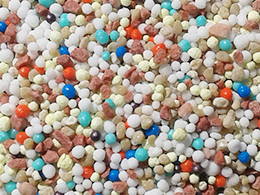Fertilizer Production Line
Let’s Start Work
Together
Please feel free to contact us. We will get back to you with 1-2 business days. Or just call us now.


NPK Blending Fertilizer Production Line
The BB fertilizer production line is a specialized production line for producing mixed fertilizers. Through physical mixing, different types of elemental fertilizers (such as urea, diammonium phosphate, potassium sulfate, etc.) are mixed in specific proportions to form a nutritionally comprehensive and proportion adjustable compound fertilizer. This production method has high flexibility and can quickly respond to market demand for different formula fertilizers, while avoiding the complex process and high energy consumption of chemical synthesis fertilizers.
Equipment Composition
The BB fertilizer production line mainly consists of the following equipment:
Raw material storage and transportation system: including raw material warehouse, screw conveyor or bucket elevator, used for storing and transporting various elemental fertilizer raw materials.
Raw material measurement system: using high-precision measuring equipment (such as belt scales, spiral scales, etc.) to accurately control the amount of various raw materials added according to the formula.
Mixing system: High efficiency mixers such as dual axis blade mixers, disc mixers, etc. are used to thoroughly mix the measured raw materials evenly.
Cooling and screening system: The mixed fertilizer may have a high temperature and needs to be cooled by a cooling machine, and then removed by a screening machine to ensure uniform particle size.
Packaging system: including automatic weighing machine and packaging machine, which automatically weigh and package the cooled and screened finished fertilizers.
Control System: Using PLC (Programmable Logic Controller) or DCS (Distributed Control System) to achieve automated control of the production line, including raw material metering, mixing time, temperature control, etc., to ensure stable product quality.
Granulation process
1. Raw material preparation
Raw material storage: Various elemental fertilizers (such as urea, diammonium phosphate, potassium sulfate, etc.) are stored in the raw material warehouse to ensure sufficient and stable supply of raw materials.
Raw material pretreatment: If the raw material needs to be crushed or screened to achieve the appropriate particle size, it will be carried out at this stage.
2. Measurement
Raw material measurement: Accurately measure the amount of each raw material added according to the preset formula ratio using high-precision measuring equipment such as belt scales, spiral scales, etc. This step ensures the accurate proportion of nutrients in the mixed fertilizer.
3. Mixing
Raw material mixing: The measured raw materials are fed into a mixer, such as a double shaft blade mixer or a disc mixer, to fully mix various raw materials evenly through mechanical force, forming a nutritionally comprehensive compound fertilizer.
4. Cooling
Fertilizer cooling: The mixed fertilizer may generate a certain amount of heat due to friction, and its temperature is lowered to a suitable level through a cooling machine to avoid the impact of high temperature on fertilizer performance.
5. Screening
Fertilizer screening: After cooling, the fertilizer is passed through a screening machine to remove any clumps or oversized particles that may form, ensuring uniform particle size of the finished fertilizer and improving the appearance and effectiveness of the product.
6. Packaging
Automatic packaging: The screened finished fertilizer is weighed by an automatic weighing machine and then sent to the packaging machine for automatic packaging into bags or boxes, ready for storage or transportation.
7. Quality control
Finished product inspection: Before or after packaging, quality inspection is carried out on the finished fertilizer to ensure that its nutritional composition ratio, particle size, and other indicators meet the standards.
Process characteristics
- Flexible formula: The BB fertilizer production line can quickly adjust the formula according to crop needs and soil conditions, producing a variety of compound fertilizers in different proportions to meet diverse market demands.
- High production efficiency: The production line adopts automated control, with fast production speed and high efficiency, enabling large-scale production.
- Low energy consumption: Compared to chemically synthesized fertilizers, the production process of BB fertilizer involves physical mixing, resulting in lower energy consumption and greater environmental friendliness.
- Stable product quality: Through precise raw material measurement and efficient mixing equipment, the nutritional composition of the finished fertilizer is ensured to be uniform and stable.
- Relatively low investment cost: Compared to chemical synthetic fertilizer production lines, BB fertilizer production lines have lower equipment investment and maintenance costs.





